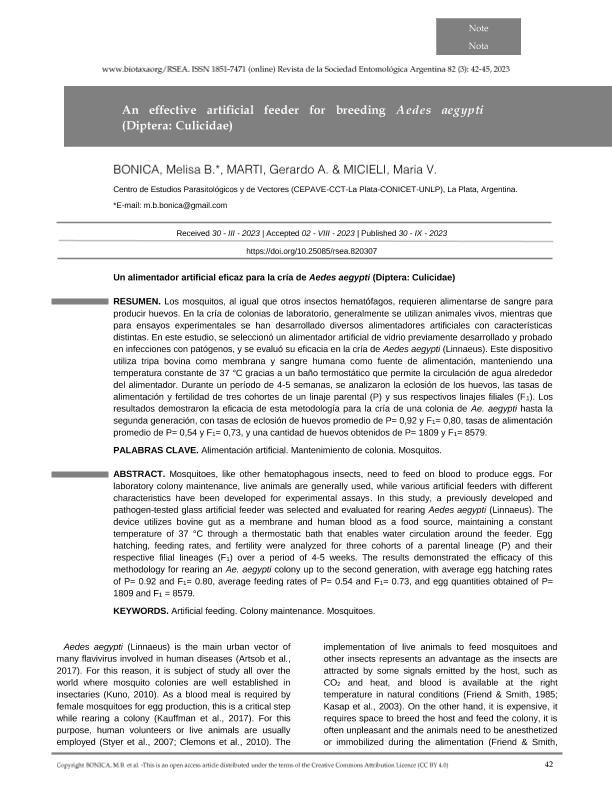Artículo
Mosquitoes, like other hematophagous insects, need to feed on blood to produce eggs. For laboratory colony maintenance, live animals are generally used, while various artificial feeders with different characteristics have been developed for experimental assays. In this study, a previously developed and pathogen-tested glass artificial feeder was selected and evaluated for rearing Aedes aegypti (Linnaeus). The device utilizes bovine gut as a membrane and human blood as a food source, maintaining a constant temperature of 37 °C through a thermostatic bath that enables water circulation around the feeder. Egg hatching, feeding rates, and fertility were analyzed for three cohorts of a parental lineage (P) and their respective filial lineages (F1) over a period of 4-5 weeks. The results demonstrated the efficacy of this methodology for rearing an Ae. aegypti colony up to the second generation, with average egg hatching rates of P= 0.92 and F1= 0.80, average feeding rates of P= 0.54 and F1= 0.73, and egg quantities obtained of P= 1809 and F1 = 8579. Mosquitoes, like other hematophagous insects, need to feed on blood to produce eggs. For laboratory colony maintenance, live animals are generally used, while various artificial feeders with different characteristics have been developed for experimental assays. In this study, a previously developed and pathogen-tested glass artificial feeder was selected and evaluated for rearing Aedes aegypti (Linnaeus). The device utilizes bovine gut as a membrane and human blood as a food source, maintaining a constant temperature of 37 °C through a thermostatic bath that enables water circulation around the feeder. Egg hatching, feeding rates, and fertility were analyzed for three cohorts of a parental lineage (P) and their respective filial lineages (F1) over a period of 4-5 weeks. The results demonstrated the efficacy of this methodology for rearing an Ae. aegypti colony up to the second generation, with average egg hatching rates of P= 0.92 and F1= 0.80, average feeding rates of P= 0.54 and F1= 0.73, and egg quantities obtained of P= 1809 and F1 = 8579.
An effective artificial feeder for breeding Aedes aegypti (Diptera: Culicidae)
Título:
Un alimentador artificial eficaz para la cría de Aedes aegypti (Diptera: Culicidae)
Fecha de publicación:
09/2023
Editorial:
Sociedad Entomológica Argentina
Revista:
Revista de la Sociedad Entomológica Argentina
ISSN:
0373-5680
Idioma:
Inglés
Tipo de recurso:
Artículo publicado
Clasificación temática:
Resumen
Palabras clave:
ARTIFICIAL FEEDING
,
cCOLONY MAINTENANCE
,
MOSQUITOES
Archivos asociados
Licencia
Identificadores
Colecciones
Articulos(CEPAVE)
Articulos de CENTRO DE EST.PARASITOL.Y DE VECTORES (I)
Articulos de CENTRO DE EST.PARASITOL.Y DE VECTORES (I)
Citación
Bonica, Melisa Berenice; Marti, Gerardo Anibal; Micieli, Maria Victoria; An effective artificial feeder for breeding Aedes aegypti (Diptera: Culicidae); Sociedad Entomológica Argentina; Revista de la Sociedad Entomológica Argentina; 82; 3; 9-2023; 42-45
Compartir




